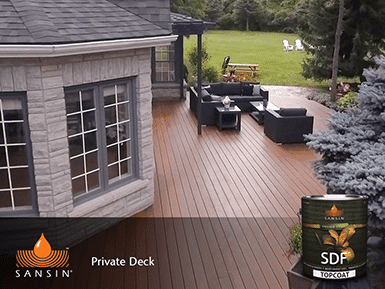Modified Woods
The selection of modified woods continues to grow. Many are modified through either temperature or chemical process to withstand high moisture environments, deliver high dimensional stability and overall durability.
Sansin has developed specially formulated products and colors to work in concert with modified wood types, such as Accoya and thermally modified for example, to deliver not only performance, but also exceptional clarity.
Sansin SDF
Penetrating one-coat finish for wood siding.


- Has been time tested in Europe & North America
- Low VOC’s
- Water Clean Up
- Low Odor
Sansin SDF provides tough, effective protection for wood siding. SDF’s specially formulated oils and resins penetrate into the wood, providing outstanding weather and UV protection in a wide range of natural, semi-transparent and even solid colors. Thanks to SDF’s unique water-borne technology, it can provide complete protection in just one coat – although a second coat will provide an even more beautiful and richer finish.
And because SDF is designed to be highly water-repellent, it’s a natural choice for homes and structures in moisture-rich environments. Not only does SDF protect the outside of your wood, it also protects the inside by allowing the wood to “breathe” which helps prevent moisture from getting trapped in the wood and causing rot.
Sansin SDF Top Coat
Durable topcoat to build a low lustre, natural finish


- Has been time tested in Europe & North America
- Low VOC’s
- Water Clean Up
- Low Odor
Sansin SDF Topcoat is a highly protective, exceptionally durable top-coat system that can be applied to any SDF base coat system including SDF Foundation for a fuller, satin-like finish – for substrates including siding, soffits, decks, logs, and timbers. SDF Topcoat is highly durable against moisture and weathering and is available in four tintable bases.
It is UV stable, water-repellent, low in VOC’s, and non-flammable with easy soap and water cleanup. SDF Topcoat will not crack, peel, or blister. Maintenance applications can be planned every four to six years on vertical surfaces depending on the number of coats applied.

